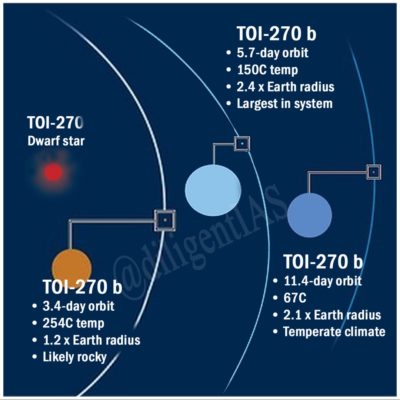NASA’s TESS discovers three new planets nearby 04/08/2019 – Posted in: Daily News – Tags: TOI 270 planetary system, Transiting Exoplanet Survey Satellite (TESS)
NASA’S TESS DISCOVERS THREE NEW PLANETS NEARBY
For: Preliminary & Mains
Topics covered: Discovery of three new exoplanets, Major findings, Transiting Exoplanet Survey Satellite
News Flash
NASA’s Transiting Exoplanet Survey Satellite, or TESS, has discovered three new worlds that are among the smallest, nearest exoplanets known to date.
The planets orbit a star just 73 light-years away and include a small, rocky super-Earth and two sub-Neptunes – planets about half the size of our own icy giant.
Major Findings
- TOI 270 is about 73 light-years away from Earth and is located in the constellation Pictor.
- Its members include the dwarf star, which is 40 percent smaller than the Sun in size and mass, and the three planets or exoplanets (planets outside the solar system) that have been named TOI 270 b, TOI 270 c, and TOI 270 d.
- All three planets appear to be relatively close in size.
- The star is an M-dwarf, a type of star that is normally extremely active, with frequent flares and solar storms.
- These three planets orbit the star every 3.4 days, 5.7 days, and 11.4 days respectively.
- In this system, TOI 270 b is the innermost planet. Researchers expect it to be a rocky world about 25 per cent bigger than Earth.
- TOI 270 b is not habitable as it is located too close to the star — about 13 times closer than our Solar System’s Mercury is from the Sun.
- TOI 270 c and TOI 270 d are Neptune-like planets because their compositions are dominated by gases rather than rock.
- Planet TOI 270 d is suspected to have a rocky core covered by a thick atmosphere.
- TOI 270 d offers a surface unfavourably warm for the existence of liquid water.
They named the star TOI-270, for the 270th “TESS Object of Interest” identified to date.
Three orbiting exoplanets
- Planet b is a rocky super-Earth with a roughly three-day orbit
- The Planet c is a sub-Neptune with a five-day orbit
- Planet d is another sub-Neptune slightly further out, with an 11-day orbit.
Way ahead
With further study and observations, researchers expect to find the composition of these planets, the presence of atmosphere in them and the kinds of gases they contain, etc.
Transiting Exoplanet Survey Satellite (TESS)
- The TESS is a space telescope for NASA’s Explorers program.
- It is designed to search for exoplanets using the transit method in an area 400 times larger than that covered by the Kepler mission.
- TESS will survey 200,000 of the brightest stars near the sun to search for transiting exoplanets.
- TESS launched on April 18, 2018, aboard a SpaceX Falcon 9 rocket.
- The primary mission objective for TESS is to survey the brightest stars near the Earth for transiting exoplanets over a two-year period.
Source: Indian Express
Also, read more daily News
- The Intermediate-Range Nuclear Forces Treaty (INF)
- External Commercial Borrowing
- National Commission of Minorities
- RoboBee X-Wing
- Banning of Unregulated Deposit Schemes Bill 2019
- Anti-microbial peptide
You are on the Best Online IAS preparation platform. You are learning under experts.
We are present on Facebook- Diligent IAS, LinkedIn- Diligent IAS, YouTube- Diligent IAS, Instagram- Diligent IAS. Get in touch with us.

